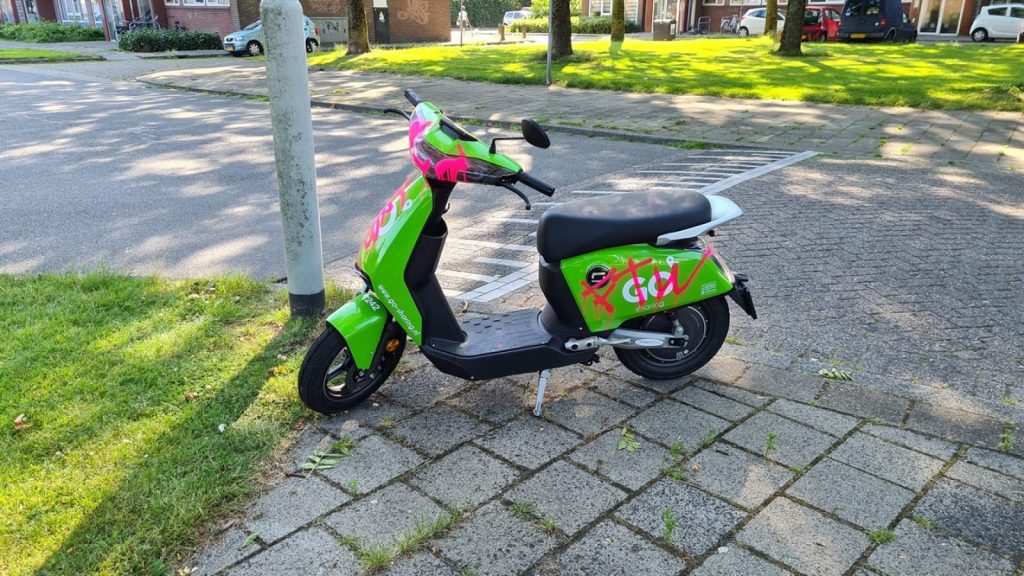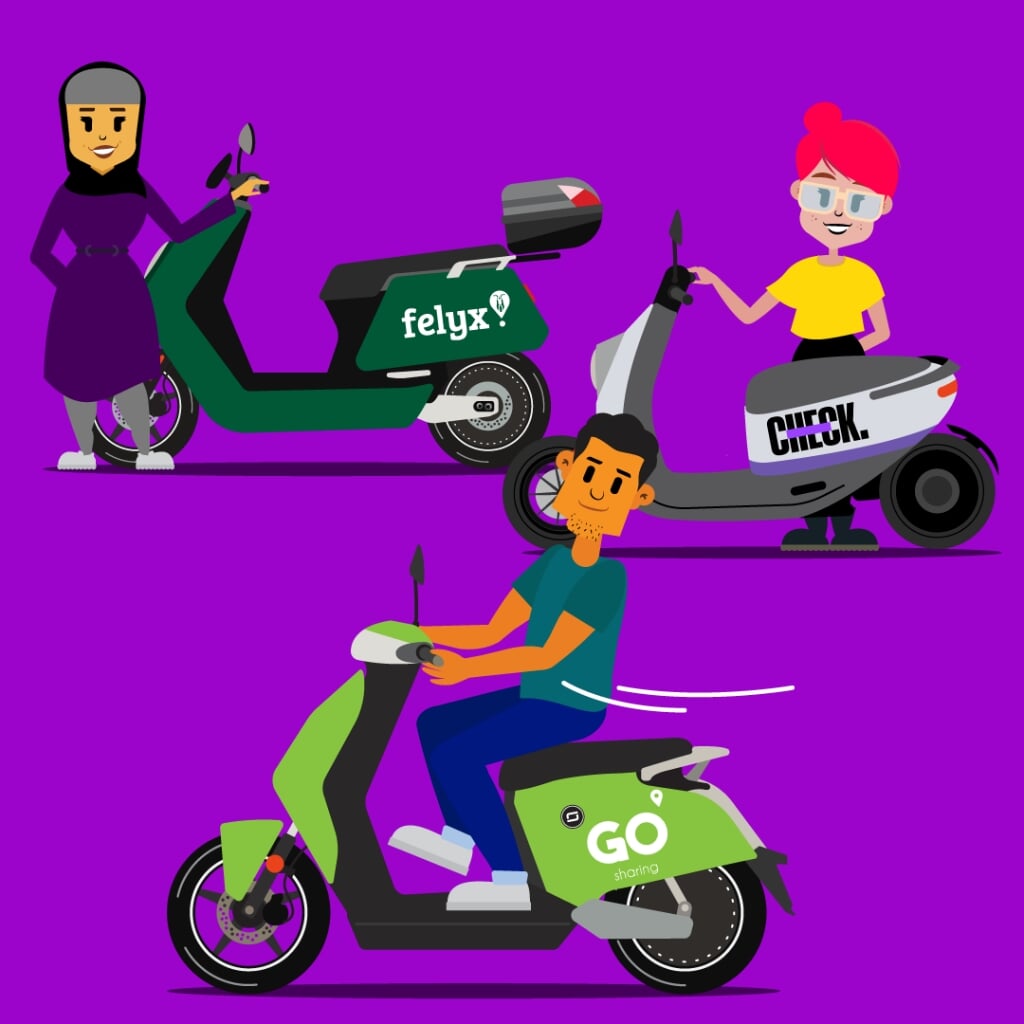A few years ago a new phenomenon has emerged: shared e-scooters. At this point in time, the effects of shared e-scooters on transport are undeniable. It has gotten to a point where cities without e-sharing scooters have become unthinkable, as most people living in a city have used e-scooters or have at least heard about the concept. E-Scooter Sharing has both its advantageous and disadvantageous.
In short, shared e-scooters are electric mopeds that users can unlock using their phone. Users can then drive the moped, short distance, within a designated city/area. Furthermore, the e-scooters are dockless and available 24/7. The companies that issue the e-scooters oversee whether the battery is charged, reparations, maintenance, etc. The main e-scooter providers in the Netherlands are Felyx, Check and Go-Sharing.
One of the main advantages of e-scooter sharing is that it contributes to more connectivity with a city, making it easier to go from one place to another (source 1). That is, some areas of a city are less reachable by public transport and at certain hours of the day (i.e. at night/early morning) public transport is not fully operational. E-scooter sharing partly solves this issue, as the e-scooters are readily available throughout the day in several (including difficult to reach) areas of the city. As such, e-scooters have become an important part of transportation networks in several cities already. Second, e-scooters are convenient, as they are easy to use and take the hassle of owning a scooter away. That is, owning a scooter comes with quite a lot of costs (maintenance, storage, etc.) and with the high risk of theft. By renting an e-scooter this hassle is avoided. Third, e-scooter sharing is relatively eco-friendly, as all scooters run on electricity. Moreover, the fact that scooters are shared, as opposed to owned by individual people, means that one scooters is used more often and by more people. A recent study by Dias et al. (2021) found that e-scooters indeed help combat several environmental issues that cities cope with, such as air pollution (source 2). Lastly, also according to the study by Dias et al (2021), e-scooters help reduce inequalities with regards to access to (public) transport (source 2). As such, one could argue that e-scooter sharing is a disruptive innovation: it has made transport affordable and accessible to a new/wider audience (source 3).

One of the disadvantages of e-scooters is, in my opinion, that it promotes laziness and passiveness. People tend to sometimes choose to use a shared e-scooter, when they have a perfectly fine, working bike. Second, e-scooters are a nuisance to some people (source 4). The e-scooters are sometimes parked in the wrong place, swarm the roads, etc. Also, drivers of the scooters are not always fully aware of the local (moped) traffic rules, which means some dangerous situations can occur. Third, the e-scooters are prone to theft and vandalism (source 5). Although the e-scooters have systems in place against theft and vandalisms, the e-scooters can be hacked, stolen and/or destroyed. You would think this is a big issue for the companies issuing the e-scooters, but because of the relatively low purchase price of the e-scooters (which are bought in bulk), it is in fact not a mayor threat to their business (source 5).

In short, E-Scooter Sharing contributes to connectivity within a city, is convenient, is relatively sustainable and reduces inequality. However, E-Scooter Sharing does promote laziness and passiveness, is a nuisance to some and is vulnerable to theft and vandalism.
Although there are some drawbacks, E-Scooter Sharing is here to stay, in my opinion. To me, the convenience and ease of use of the concept make it a true asset. Instead of having to wait for the tram for 15 minutes when your bike is broken, you can now make use of an e-scooter. Moreover, there are some exciting possibilities for innovation. E-scooters with smart cameras could for example contribute to making the city a safer place (source 6) and e-scooters could be integrated with the existing public transport network thus turning it into Mobility as a Service (MaaS) (source 7).
References (Pictures):
1. https://www.rtlnieuws.nl/tech/artikel/5033551/elektrische-deelscooter-scooters-huren-escooter-felyx-check-go-sharing
2. https://www.volkskrant.nl/nieuws-achtergrond/de-elektrische-scooter-is-het-snelst-groeiende-deelvervoer-in-de-stad-felyx-wil-nu-internationaal-vliegen~b2c6ab51/
3. https://www.nhnieuws.nl/nieuws/289113/vier-dagen-na-start-al-vier-deelscooters-in-beverwijk-uitgebrand-besmeurd-of-vernield
References (Text):
1. https://news.mit.edu/2021/e-scooters-new-micro-mobility-service-0622
2. Dias, G., Arsenio, E., & Ribeiro, P. (2021). The Role of Shared E-Scooter Systems in Urban Sustainability and Resilience during the Covid-19 Mobility Restrictions. Sustainability, 13(13), 7084. https://doi.org/10.3390/su13137084
3. Christensen, C. M., Raynor, M. E., & McDonald, R. (2015). What is disruptive innovation? Harvard Business Review, 93(12), 44-53.
4. https://news.law.fordham.edu/jcfl/2018/12/02/the-rise-of-the-electric-scooter-industry/
5. https://mashable.com/article/e-scooter-hacks-bird-lime
6. https://www.euronews.com/next/2021/09/13/eyes-on-the-road-can-e-scooters-with-cameras-protect-pedestrians-and-make-our-cities-safer
7. Arias-Molinares, D., & Carlos García-Palomares, J. (2020). Shared mobility development as key for prompting mobility as a service (MaaS) in urban areas: The case of Madrid. Case Studies On Transport Policy, 8(3), 846-859. https://doi.org/10.1016/j.cstp.2020.05.017


Nice article, with well-found arguments! I am totally in favour of e-scooters and the whole network of how they are set-up within Dutch cities. I agree with the benefits you have listed and especially like the part about e-scooters being a disruptive innovation. The fact that it improves connectivity within cities for its citizens, while also lowering the boundary of driving a moped means that it has an increased accessibility to its users. Quality transport is being made more affordable for citizens with these scooters.
With the drawbacks however, I think even some of those do not cause that much of an issue. For example, the laziness can indeed be promoted with these scooters, but since the scooters do cost money (which will add up quite quickly in my experience) I think people will still prefer their bikes for short rides to the supermarket, for example. Furthermore, considering the nuisance they cause, since the scooters have limited parking spaces throughout the city, the annoyance of having a scooter parked in an inconvenient spot is limited to a minimum. Regarding the user’s knowledge of the traffic rules, one has to confirm their driver’s license before being able to rent a scooter.
Overall, I agree with your opinion and support the e-scooter idea!